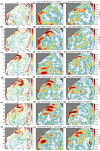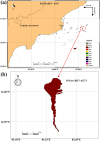Extraction of persistent lagrangian coherent structures for the pollutant transport prediction in the Bay of Bengal
- PMID: 38627496
- PMCID: PMC11021457
- DOI: 10.1038/s41598-024-58783-4
Extraction of persistent lagrangian coherent structures for the pollutant transport prediction in the Bay of Bengal
Abstract
Lagrangian Coherent Structures (LCS) are the hidden fluid flow skeletons that provide meaningful information about the Lagrangian circulation. In this study, we computed the monthly climatological LCSs (cLCS) maps utilizing 24 years (1994-2017) of HYbrid Coordinate Ocean Model (HYCOM) currents and ECMWF re-analysis winds in the Bay of Bengal (BoB). The seasonal reversal of winds and associated reversal of currents makes the BoB dynamic. Therefore, we primarily aim to reveal the cLCSs associated with seasonal monsoon currents and mesoscale (eddies) processes over BoB. The simulated cLCS were augmented with the complex empirical orthogonal functions to confirm the dominant lagrangian transport pattern features better. The constructed cLCS patterns show a seasonal accumulation zone and the transport pattern of freshwater plumes along the coastal region of the BoB. We further validated with the satellite imagery of real-time oil spill dispersion and modelled oil spill trajectories that match well with the LCS patterns. In addition, the application of cLCSs to study the transport of hypothetical oil spills occurring at one of the active oil exploration sites (Krishna-Godavari basin) was described. Thus, demonstrated the accumulation zones in the BoB and confirmed that the persistent monthly cLCS maps are reasonably performing well for the trajectory prediction of pollutants such as oil spills. These maps will help to initiate mitigation measures in case of any occurrence of oil spills in the future.
Keywords: Accumulation; Bay of Bengal; Eddies; HYCOM; LCS; Pollutants; Prediction; Trajectory.
© 2024. The Author(s).
Conflict of interest statement
The authors declare no competing interests.
Figures











References
-
- Trinadha Rao V, Suneel V, Gurumoorthi MJ, Thomas AP. Assessment of MV Wakashio oil spill off Mauritius, Indian Ocean through satellite imagery: A case study. J. Earth Syst. Sci. 2022;131:21. doi: 10.1007/s12040-021-01763-3. - DOI
LinkOut - more resources
Full Text Sources

